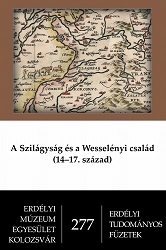Az ákosi monostor és az Ákos nemzetség
The Abbey and Kindred of Ákos
Author(s): Péter Levente Szőcs
Subject(s): Local History / Microhistory
Published by: Erdélyi Múzeum-Egyesület
Summary/Abstract: The settlement of Acâș (Ákos, Satu Mare/Szatmár County, Romania) has played a central role during the Middle Ages, being on the cross point of the main trade route which passed along the Crasna (Kraszna) River and turned here toward North, to the city of Satu Mare (Szatmár). From the medieval monastery of Ákos only the abbey church is preserved, transformed now into Calvinist church. The good state of the edifice confers a special role to it among the Romanesque monuments of medieval Hungary, offering the possibility of an exhaustive architectural analysis, though the scarcity of written documents makes the historical context less clear.The abbey-church is a triple-aisled basilica with one apse, and two western towers – with a gallery between them. It is built by brick, only several significant parts were realized of stone: the door-frames, the niches of the side altars and the headings of the pillars. The bricks used during the first construction phase can be observed all around the masonry of the church, even today, demonstrating the fact that it was built in a single phase. The eastern arrangement of the church is fairly well developed, being composed of a main apse, in front of which there is a rectangular space, connected to the side altars with two levels, and an annexed chapel on the northern side. The western complex has a special arrangement, too: the rooms of the two leveled gallery forms a common space, though they are opened toward the naves through arches. The closest similarity to the ground-plan arrangement of the Ákos abbey-church was detected by Sándor Tóth: a prolonged apse and rectangular side altars were built to the long naves during the third building-phase of the abbey-church of Csoltmonostor. The eastern arrangement of Ákos can be found with slight variations at Herina (Harina) and Boldva, while the earliest examples of similar western arrangement are from the middle of the twelfth century, being wide spread during the thirteenth century.The archaeological researches had a preventive character being limited by the partial renovations of the building. Inside of the church, the north-eastern side altar was researched, in order to verify the hypothesis of the eastern towers. The discovered foundations, however, can not be linked to any tower, being built in later phases; therefore, the presumption of the eastern towers must be rejected. There were identified several floors and the remnants of the staircase which led from the side altar to the main apse. On the exterior, at the north-eastern corner of the church, the foundations of a small side chapel with an apse were identified, built together, in a single phase, with the church. Moreover, around the abbey church a deep and rather wide ditch was identified, which surrounded the early monastic complex, being filled up during the late Middle Ages. Through the archaeological excavations 76 burials were identified, belonging to two chronological groups. Roughly one third of the graves can be dated on the basis of the discovered finds to the Middle Ages (13th to 15th centuries), while the others are more recent, dating from the 18th to 19th century. The earliest coin discovered dates from 1170-1200. The kindred of Ákos had seven branches during the Middle Ages, the earliest sources dating from the beginning of the 12th century, though the exact lineage of the early period can not be established. Written documents on the kindred’s history became more frequent starting with the thirteenth century, therefore, their estates and genealogy can be established only at that moment. It seems, that the estates of Middle Solnoc and Bihor (Bihar) Counties, were the oldest possessions of the kindred, forming a single block along the rivers of Kraszna, Ér and Berettyó. During this period, the kindred had three monasteries Ákosmonostor at the Crasna River, Pályi at the Berettyó River, and again Ákosmonostor, in the valley of Galga River in Pest County. The Ákosmonostora in Middle Szolnok County, at the Crasna River, seems to be earlier foundation than the others: the archaeological finds and the art historical analysis suggest that it was established during the last part of the 12th century. The later evolutions of the three monasteries were somewhat similar: none of the descendants of the patrons paid much interest in these ancestral establishments.In the case of Ákos in Middle Szolnok, in spite of the scarcity of historical sources, it can be assumed that the settlement was an early center of the Ákos kindred. The monastery established here, was probably the earliest one of the kindred, but it was inherited by descendants who gradually became impoverished. The monastery was lost by them, and then it was transformed to a parish church – thus guaranteeing its survival.
Book: A Szilágyság és a Wesselényi család (14–17. század)
- Page Range: 7-24
- Page Count: 18
- Publication Year: 2012
- Language: Hungarian
- Content File-PDF

